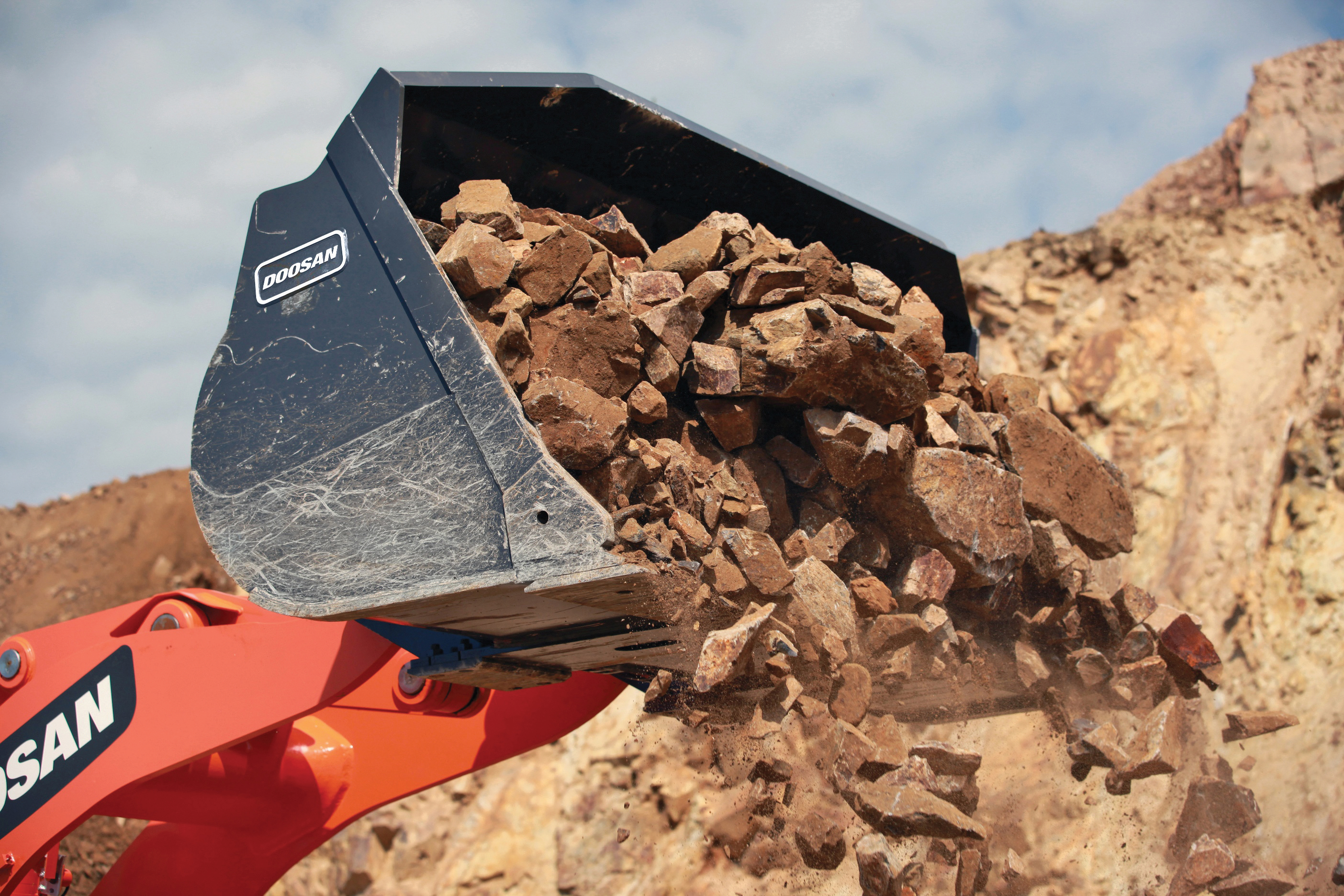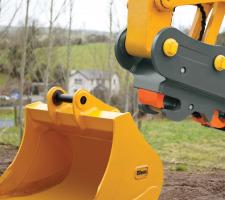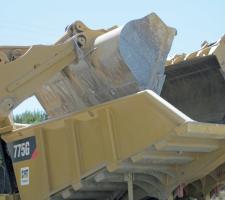
Machine choice can be critical to a quarry’s productivity and matching a loader or excavator with a hauling solution to maximise efficiency has never been so important, writes Dan Gilkes
However, all of that good work can to some extent be undone if the loader is fitted with the wrong type or size of bucket.
In some respects buckets are like tyres. For some customers they are just a black hoop of rubber that keeps the machine off the ground, when in reality the modern earthmover tyre is a complex mix of compounds and reinforcing, with a grip pattern designed to maximise traction and minimise fuel consumption.
Likewise a bucket is not simply the big metal scoop that came with the machine when it was first purchased. Whether it has the right profile, the ideal cutting edge and teeth to penetrate the face, the correct size to allow the machine to easily lift and load, should not be a secondary consideration. Get it wrong and the machine can be unproductive, inefficient and costly to run.
This was reinforced at the recent
It was pointed out that selection of such attachments is usually based on three major performance characteristics, strength, penetration and wear life, and that selection is a balance of these characteristics.
For example, the choice of GET should be prioritised from the most to least important, and should also be influenced by operator technique and pit conditions.
The company offers a variety of attachments including a wide range of buckets that are manufactured to match with machines and offer the maximum productivity.
There is certainly no shortage of choice for buyers, with both original equipment machinery manufacturers (OEMs) and independent bucket makers competing for your business.
Each bucket has been designed to fit specific models in the Doosan line-up, working within the kinematic parameters of the wheeled loader. The buckets are matched to the tipping loads of the machine for maximum stability and safe operation.
The range includes general purpose, heavy duty and dedicated rock buckets.
Quick hitch safety has also been high on the agenda for many over the last few years, with fully automated hitches now proving the most popular.
Miller International, one of the leading manufacturers of buckets and couplers, has launched the Miller Mate to combat incorrect use of quick hitches.
The in-cab device is said to simplify the safe and correct operation of a quick coupler during the attachment changeover process. It replaces the existing toggle-style switch with a simple and intuitive full-colour LED interface that can be mounted in the cab of any new or existing machine.
“We realised that coupler safety has always focused on the design of the coupler itself, but if there is ever an incident with a quick coupler it is those working nearby who are affected,” says Keith Miller, chairman of Miller International.
“The new product helps to minimise the potential risks to those working in the vicinity of the machine.”
The in-cab display shows graphic illustrations of the correct operating procedure as per the manufacturer’s recommendations. It encourages the operator to place the quick coupler in the correct positions throughout attach and release processes.
Miller Mate operates the hydraulic cylinder within the coupler only when the operator has confirmed it is at the correct stage of the process, and it includes dynamic safety checks too and these are carried out every time the unit is switched on, with potential problems displayed on the screen to alert the operator. The system also logs every changeover to monitor the operator’s performance and flag up any potentially dangerous errors.
It is not just wheeled loader buckets that have seen activity, as
The buckets for the larger excavators are optimised for ground penetration and have been built from high-tensile steel with wear plates for durability.
The general purpose range is said to be ideal for digging and rehandling soft-to-medium materials, and is available in several direct-fit or quick-coupler designs, while the heavy duty buckets suit mining or quarrying applications.
Returning to quick hitches, an increasing number of companies rely on the technology to allow rapid changes from bucket to breaker or ripper, increasing productivity and reducing downtime.
However, operators should remember that installing a quick hitch can radically alter the kinematic design and performance of a machine, as it in effect increases the length of the dipper arm.
This may lead to a requirement for a slightly smaller bucket, or one with a different design to cope with the additional stick length and pin position.
As the new bucket or attachment is connected the main pin locks in place even before the bucket link end of the hitch is located, ensuring the bucket can’t be dropped.
Hill Engineering has also been working on its quick hitches, the recently launched TEFRA Coupler being the result. The coupler, which fits excavators from 3-120tonnes, is said to eliminate one of the most dangerous aspects of handling attachments: the risk of attachments coming away completely.
Crusher bucket becoming popular
Buckets, breakers and rippers are not the only attachments in use in quarry and construction applications, particularly those that involved recycling of material. The crusher bucket is becoming an increasingly popular means of recycling construction and demolition waste, to provide reusable aggregate.
Meanwhile,

















